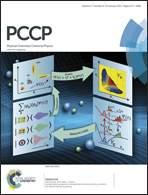The effect of donor content on the efficiency of P3HT:PCBM bilayers: optical and photocurrent spectral data analyses†
Abstract
State-of-the-art organic solar cells mostly rely on bulk-heterojunction architectures, where the photoactive layer is cast from a solution containing both the electron donor and acceptor components and subsequently annealed. An alternative route for device preparation is the sequential deposition of the two components using “orthogonal” solvents. The morphology of sequentially deposited bilayers has been extensively studied, but the interplay between optical and electrical properties and its influence on device efficiency is still unclear. Here we present a study of poly(3-hexylthiophene) (P3HT):phenyl-C61-butyric acid methyl ester (PCBM) bilayers with variable P3HT content, including also a standard bulk-heterojunction device for comparison. Measured optical absorption, external quantum efficieny (EQE), and internal quantum efficiency (IQE) data are analysed and interpreted with the aid of numerical models. In agreement with other studies, our results suggest substantial intermixing between the PCBM and P3HT component, regardless of the P3HT content. In the bulk heterojunction and the bilayer devices with an active layer thickness of 100 nm or less, our best fits to both the optical and optoelectronic data highlight a concentration inversion, with an accumulation of PCBM on the anode side. Through the numerical analysis of device performance at short-circuit, we also find that exciton diffusion toward the P3HT:PCBM interface and geminate recombination can be the main IQE loss factors. Additional losses, attributed to bimolecular electron–hole recombination, are also observed upon increasing the P3HT content.


 Please wait while we load your content...
Please wait while we load your content...